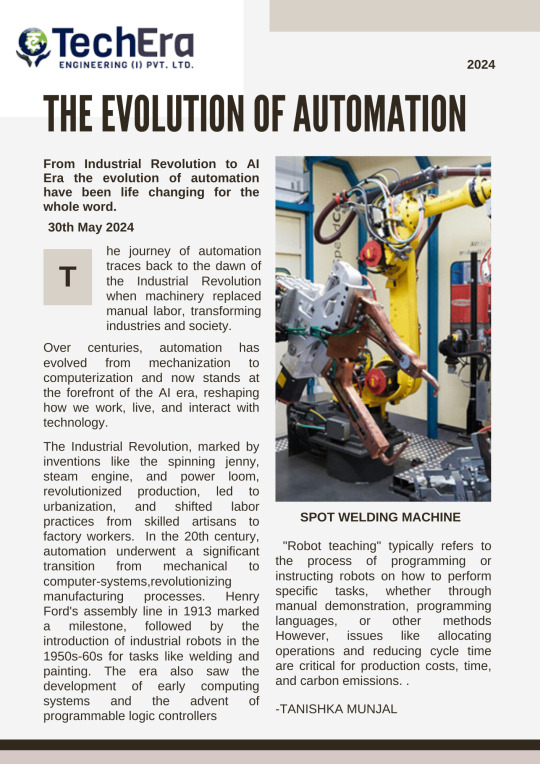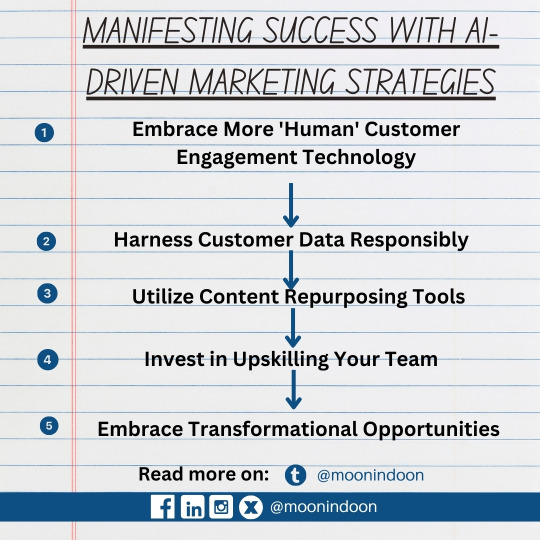#Intelligent Automation market
Explore tagged Tumblr posts
Text
#intelligent automation market#global intelligent automation market report#automation market research reports#intelligent process automation market#intelligent automation market size#Intelligent Automation solutions
0 notes
Photo

What is an Algorithm in 30 Seconds?
An algorithm is simply a series of instructions.
Think of a recipe: boil water, add pasta, wait, drain, eat. These are steps to follow.
In computer terms, an algorithm is a set of instructions for a computer to execute.
In machine learning, these instructions enable computers to learn from data, making machine learning algorithms unique and powerful.
#artificial intelligence#automation#machine learning#business#digital marketing#professional services#marketing#web design#web development#social media#tech#Technology
69 notes
·
View notes
Text
🚀 Explore how AI can transform your B2B marketing strategy! Discover actionable tactics to enhance buyer engagement and create personalized experiences. Dive into AI-driven buyer-centric strategies today! #B2BMarketing #AI #BuyerEngagement #DigitalMarketing
#account-based marketing#AI#AI-driven marketing#automated nurturing#B2B marketing#brand awareness#buyer enablement#buyer experiences#buyer journeys#buyer-centric strategies#buying groups#campaign effectiveness#content distribution#conversion rate optimization#customer engagement#data analysis#demand intelligence#digital marketing#engagement#lead generation#marketing automation#marketing insights#multi-touch attribution#omnichannel experience#performance insights#personalization#resource optimization
4 notes
·
View notes
Text
Unlock the secrets to success with "5 Habits of Millionaire Entrepreneurs You Need to Copy!" In this insightful video, we dive deep into the daily routines and mindsets of the world’s wealthiest entrepreneurs. Discover how these powerful habits can transform your productivity, boost your creativity, and elevate your business acumen. Whether you're an aspiring entrepreneur or a seasoned business owner, adopting these strategies can lead to remarkable growth and financial success.
Don't forget to like and share this video with anyone looking to level up their entrepreneurial game!
#MillionaireMindset #EntrepreneurHabits #SuccessTips #BusinessGrowth #FinancialFreedom
#marketing#affiliatemarketing#business#success#business automation#passive income strategies#artificial intelligence#machine learning solutions#passive income
2 notes
·
View notes
Text

The most awaited article of the year is here ... Evolution of automation is all yours now !!!
#aerospace#automation#machine learning#artificial intelligence#success#inspiring quotes#architecture#article#trending#viral#viral trends#market trends#viralpost#automotive#automatically generated text#software#engineering#search engine optimization
9 notes
·
View notes
Text
🌐 The Future of AI & Automation is Here! 🌐
Step into tomorrow with AOMA AI Agency! From business automation to enhancing productivity, our AI-driven solutions are designed to elevate your brand and optimize your operations. Let us take care of the tech while you focus on growing your business. 🚀Boost your marketing ROI and prepare your brand for the future with expert digital solutions! 💼💡
#startup#entrepreneur#small business#artificial intelligence#artists on tumblr#branding#ecommerce#finance#investing#marketing#leadgeneration#automation
3 notes
·
View notes
Text
E-commerce Marketing Automation Streamlining Your Online Sales Strategy

If you want your e-commerce strategies to run more smoothly automation tools are essential. It is challenging to provide each customer with the ideal incentive for purchase or to provide personalized offers to each one in real-time.
But you can do that with the assistance of an automated workflow. You can significantly increase your conversion rates by engaging visitors at the right times. You want to optimize each site visit and set up workflows for marketing automation.
However, you can increase conversion rates without spending a lot of time on manual tasks by establishing straightforward marketing automation processes.
How many people visit your website each day? An e-commerce site with an average conversion rate of 2.3% will unavoidably lose 97.7% of its visitors.
Fundamentals of E-commerce Marketing Automation
Marketing automation is virtually necessary in the realm of online retail. As a result, this technology can help to improve the customer experience and thus is critical for successful e-commerce strategies.
Defining Marketing Automation
Essentially, marketing automation is exactly what it sounds like using a software platform to automate menial and repetitive war-room-level marketing-centric tasks. Such tasks are involved in email campaigns, social media posting and ad campaigns. Creating this system will enable us to quickly establish a connection with our audience as required.
This technology saves time but it also helps ensure our messaging is more consistent across all touchpoints. Meaning we can segment our audience automatically and create personalized experiences depending on what they do. Which in turn provides better engagement and higher customer satisfaction.
Benefits of Automating E-commerce Marketing
When we can automate our e-commerce marketing efforts the benefits are enormous. The first thing is by saving time on manual tasks we can optimize the use of our resources. We can concentrate on the important and strategic work.
Second, automation has helped me improve customer relations. With personalized communication and offers informed by customer behavior can make the shopping experience more personal. Therefore, this leads to higher conversion rates and more customer loyalty often.
Lastly, using automation tools for data analytics gives us many useful insights. We use these insights to understand performance, refine campaigns and make informed decisions on how can improve your marketing efforts.
Key Components in E-commerce Marketing Automation
There are multiple important parts we need to consider in e-commerce marketing automation. Mainly these are the automation tools. They include email marketing platforms to customer relationship management (CRM) systems.
After that we need to consider customer segmentation This allows us to segment our audience into more targeted groups by interest or buying behavior. This will also allow us to customize our marketing messages for each group accordingly.
Finally, the importance of analytics. The data we get through our automated processes will need to be parsed and analyzed before the successful measurement of our campaigns. Armed with this information. We refine our strategies to enhance future marketing efforts that will ultimately drive further growth and more engagement.
Signification of Marketing Automation
Automation tools have become crucial to survival because consumers expect more personalized interactions than ever. This way, we get automatic answers depending on user behavior so that our messages are sent to the right people at the appropriate time. It greatly assists with lead nurturing and closing sales.
#ecommerce#marketing#automation#artificial intelligence#entrepreneur#digitaltransformation#saas#software#innovation#business#digital marketing#connection#artists on tumblr
2 notes
·
View notes
Text
Cracking the Code: Manifesting Success with AI-Driven Marketing Strategies
As the domain of marketing technology continues to grow at a rapid pace and is driven by growth in artificial intelligence (AI) and personalization, marketers encounter exciting opportunities as well as daunting challenges. Adapting to these changes requires practical approaches that allow organizations to stay current, manage change effectively, and operate at scale.

In this article, we explore five practical tactics to help modern marketing teams adapt and thrive in this dynamic environment:
Embrace More 'Human' Customer Engagement Technology:
While chatbots have been around for decades, advancements in AI have significantly enhanced their capabilities. Today, AI-powered chatbots can engage with customers in a remarkably human-like manner, providing round-the-clock support and valuable insights.
Leveraging chatbots not only improves customer experience but also generates valuable data for outbound marketing initiatives. By analyzing customer queries and interactions, marketers can easily get valuable data that can enhance their marketing strategies.
Harness Customer Data Responsibly:
Customers willingly share personal information with companies, providing valuable insights into their preferences, behaviours, and sentiments. Marketers must mine this data responsibly and use it to deliver personalized experiences and targeted offers.
By leveraging predictive analytics and machine learning, marketers can analyze data faster and make informed decisions to enhance omnichannel marketing efforts.
Utilize Content Repurposing Tools:
Authentic content remains paramount in marketing, but creating content for various channels and platforms can be challenging. Content repurposing tools like Optimizely and Interaction Studio help marketers adapt long-form content into social media posts, videos, and other formats.
Expanding your content footprint not only enhances brand visibility but also allows for faster learning and adaptation to changing market dynamics.
Invest in Upskilling Your Team:
While AI-based tools offer significant automation potential, managing and mastering these technologies require skilled professionals. Marketers must invest in continuous learning and cross-functional collaboration to stay ahead.
Effective leadership and teamwork are essential for navigating the complexities of modern marketing. Encouraging knowledge sharing and collaboration across teams fosters a culture of innovation and growth.
Embrace Transformational Opportunities:
As AI continues to reshape the marketing landscape, traditional metrics of success are being redefined. Marketers must embrace the transformative potential of AI and other emerging technologies to serve their customers better.
When evaluating new ideas and technologies, marketers should prioritize customer value and align them with their brand and company values. By focusing on solutions that genuinely benefit customers, marketers can drive meaningful impact and success.
In conclusion, navigating the ever-evolving domain of AI-driven marketing requires a blend of innovative strategies and steadfast principles. By embracing more human-centric engagement technologies, responsibly harnessing customer data, utilizing content repurposing tools, investing in team upskilling, and embracing transformational opportunities, modern marketing teams can position themselves for success. The key lies in adapting to change while remaining true to customer-centric values, fostering collaboration, and prioritizing solutions that genuinely benefit the audience. With these practical tactics in hand, marketers can not only thrive but also lead the way in shaping the future of marketing.
#marketing#AI driven marketing#AI#AI-driven marketing#artificial intelligence#inteligência artificial#ai technology#ai tools#chatgpt#marketing digital#digital marketing#branding#design#human-centric engagement#innovative strategies#customer-centric values#collaboration#content tools#Upskilling#automation#software#networking#innovation#efficiency#iot#'Human' Customer Engagement Technology#user generated content#content marketing#content creation#content creator
4 notes
·
View notes
Text
Revolutionizing Advertising with AdsGency AI: Your Ultimate Ai Smart Advertising Agency
In the fast-paced world of digital marketing, staying ahead of the curve is not just an advantage – it's a necessity. Enter AdsGency AI, your ultimate Ai Smart Advertising Agency, redefining the landscape of advertising and revolutionizing the way marketing agencies operate. As an enabler of success, AdsGency AI is not here to disrupt but to spark innovation and propel your advertising endeavors to new heights.
The Power of AdsGency AI
At AdsGency AI, we understand the challenges that marketing agencies face daily – the constant juggling between platforms, the struggle to target the right audience, and the ever-evolving landscape of digital advertising. That's why we've developed a comprehensive solution that goes beyond being just a tool. AdsGency AI is a powerhouse of AI-driven capabilities that transform the advertising game.
One-Stop Ad Platform Without Limits
In a world where time is money, AdsGency AI stands out as a one-stop ad platform that streamlines your advertising efforts, saving you valuable resources. No more jumping between different tools and platforms. Our AI-driven platform is designed to be your go-to solution for all your advertising needs.
Unleashing the Power of AI
Harnessing the potential of advanced AI algorithms, AdsGency AI ensures that your advertising strategy is not just effective but optimized for success. Our AI technology analyzes vast amounts of data in real-time, allowing you to make data-driven decisions that resonate with your target audience.
Saving Time & Money
Our one-stop ads AI platform is a game-changer for marketing agencies looking to optimize their resources. By centralizing your advertising efforts, you save both time and money, allowing you to focus on what matters most – creating compelling campaigns that captivate your audience.
We Are Your Partner in Success
At AdsGency AI, we don't just provide a service; we become your partner in success. Our platform is designed to grow and evolve with your advertising needs. We're committed to staying at the forefront of technological advancements, ensuring that you always have the latest tools and strategies at your fingertips.
In conclusion, if you're looking for an Ai Smart Advertising Agency that acts as an enabler, not a disrupter, AdsGency AI is the solution you've been searching for. Our one-stop ads AI platform is your key to unlocking the full potential of your advertising strategy. Join us in shaping the future of advertising, where innovation meets efficiency, and success is inevitable. AdsGency AI – Sparking Success in Every Campaign.
#ai#ai tool#Marketing Agency Ads#Ai For Marketing#Artificial Intelligence Advertising Campaign#Marketing Advertising Agency#Ai Smart Advertising Agency#Ai Automation Agency#Ai For Marketing Campaigns#Using Ai For Marketing#Ai Marketing Agency
3 notes
·
View notes
Text























#artificial intelligence#digital marketing#generative art#generationalwealth#automation#MachineMadeArt#midjorneyart#aiartcommunity
3 notes
·
View notes
Photo

The Frame Problem: AI's Unseen Nemesis
The frame problem is AI's Achilles' heel, lurking since the 1960s and still unresolved.
1. The Robot Dilemma
Daniel Dennett's thought experiment illustrates the issue: a robot must save its battery from a room with a bomb.
Initially, the robot pulls the battery on a cart but also drags the bomb out, unaware of this side effect.
Solution attempts include programming awareness of side effects, leading to analysis paralysis as the robot debates endless possibilities.
2. The Side Effect Spiral
When programmed to consider all side effects, the robot wastes time on irrelevant details—like pondering wall color changes.
This shows how difficult it is for AI to filter relevant from irrelevant information without getting bogged down.
3. Human Intuition vs. AI Logic
Humans effortlessly ignore irrelevant details, making quick decisions in complex contexts.
Programming AI to mimic this selective ignorance is resource-intensive and remains a significant challenge.
The frame problem underscores a subtle yet crucial aspect of human intelligence: our ability to instantly prioritize relevant information. As we advance in AI development, solving this problem will be key to creating truly intelligent systems.
Got thoughts on tackling the frame problem? Share your ideas!
#artificial intelligence#automation#machine learning#business#digital marketing#professional services#marketing#web design#web development#social media#tech#Technology
21 notes
·
View notes
Text
Middle East and Africa Cleaning Robot Market Companies: Growth, Share, Value, Analysis, and Trends
"Middle East and Africa Cleaning Robot Market Size, Share, and Trends Analysis Report—Industry Overview and Forecast to 2029
The MEA Smart Cleaning Devices Market is showing significant growth across various sectors, where demand is surging due to innovation and industry expansion. Market research data reveals that businesses in the Autonomous Cleaning Robots Market are adjusting to new regulations, sustainability initiatives, and changing consumer trends. Companies operating in the AI-Powered Cleaning Market are utilizing big data and analytics to track emerging trends, optimize supply chain operations, and improve service offerings. As competition intensifies, firms in the Robotic Vacuum Cleaners Market are investing heavily in strategic market research to uncover new opportunities, address industry challenges, and shape future business models within the Home Automation Cleaning Market.
The Middle East and Africa Cleaning Robot Market is poised for significant growth, with a market outlook highlighting substantial growth potential driven by emerging opportunities in key sectors. This report provides strategic insights, demand dynamics, and revenue projections, offering a comprehensive view of the future landscape, technology disruptions, and adoption trends shaping the industry’s ecosystem evaluation. According to Data Bridge Market Research Data Bridge Market Research analyses that the market is growing with the CAGR of 20.6% in the forecast period of 2022 to 2029 and expected to reach USD 1,297.55 million by 2029.
The buzz around the Industrial Cleaning Robots Market is undeniable. It's a space that's rapidly evolving, demanding a clear understanding of its current state. From our extensive research, we've seen how shifts in consumer preferences and technological integration are reshaping the Middle East and Africa Cleaning Robot Market. Businesses are keen to grasp the real-time dynamics of the Smart Hygiene Tech Market, moving beyond assumptions to data-driven insights. Our focus is on providing that clarity, illuminating the current landscape of the Automated Housekeeping Market. The challenges and opportunities within the Middle East and Africa Cleaning Robot Market are becoming increasingly apparent. We're dedicated to helping organizations navigate the complexities of the Middle East and Africa Cleaning Robot Market. The present understanding of the Intelligent Cleaning Systems Market is vital. We are focused on providing information on the Service Robots Market. The current state of the Middle East and Africa Cleaning Robot Market is very important.
Our comprehensive Middle East and Africa Cleaning Robot Market report is ready with the latest trends, growth opportunities, and strategic analysis. https://www.databridgemarketresearch.com/reports/middle-east-and-africa-cleaning-robot-market
The Middle East and Africa Cleaning Robot Market is expected to see significant growth in the coming years, primarily driven by factors such as technological advancements, increasing awareness about hygiene, and the growing demand for automation in cleaning processes. These regions have witnessed a shift towards smart and connected solutions across various industries, including the cleaning sector. This transformation has led to the adoption of cleaning robots that offer efficient and cost-effective cleaning solutions for both residential and commercial spaces.
**Segments**
- **Product Type:** The market is segmented based on product type into floor cleaning robots, pool cleaning robots, window cleaning robots, and others. Floor cleaning robots are anticipated to dominate the market share due to their wide applicability in residential and commercial spaces. - **Application:** The market is categorized by application into residential, commercial, industrial, and healthcare sectors. The commercial and industrial segments are expected to witness substantial growth, driven by the need for advanced cleaning solutions in large spaces. - **Distribution Channel:** Distribution channels include online retail stores, specialty stores, and supermarkets/hypermarkets. The online retail segment is projected to experience rapid growth due to the convenience and accessibility it offers to consumers.
**Market Players**
- **iRobot Corporation:** A leading player in the cleaning robot market, iRobot offers a range of products such as Roomba and Braava for both residential and commercial use. The company's focus on innovation and product diversification has enabled it to maintain its competitive edge. - **Ecovacs Robotics:** Ecovacs Robotics is another key player known for its advanced robotic vacuum cleaners and window cleaning robots. The company's strong distribution network and focus on technological advancements have helped it expand its market presence. - **Samsung Electronics:** Samsung Electronics has also made a mark in the cleaning robot market with its POWERbot series of robotic vacuum cleaners. The company's brand reputation and range of features incorporated in its products have contributed to its success in the region.
Overall, the Middle East and Africa Cleaning Robot Market is poised for substantial growth, drivenThe Middle East and Africa cleaning robot market is witnessing a significant surge in demand due to various factors propelling the adoption of cleaning robots in both residential and commercial settings. Technological advancements play a crucial role in this market growth as manufacturers continually strive to improve the efficiency and effectiveness of cleaning robots. Features such as smart sensors, mapping technology, and autonomous operation are making cleaning robots more appealing to consumers looking for convenient and time-saving solutions for maintaining cleanliness. Moreover, the increasing awareness about hygiene and cleanliness standards is driving the demand for automated cleaning solutions that can ensure a high level of sanitation in diverse environments.
In addition to technological advancements, the growing demand for automation in cleaning processes is a key driver of market growth in the Middle East and Africa. Businesses and households are increasingly recognizing the benefits of using cleaning robots to streamline their cleaning operations and optimize resource utilization. With the rise of smart homes and smart buildings, there is a growing need for integrated cleaning solutions that can seamlessly fit into the connected ecosystem. Cleaning robots offer a way to achieve this integration by providing intelligent cleaning capabilities that can be remotely controlled and monitored, enhancing the overall cleaning experience for users.
The segmentation of the market into product types such as floor cleaning robots, pool cleaning robots, window cleaning robots, and others reflects the diverse applications of cleaning robots in different settings. Floor cleaning robots, in particular, are expected to dominate the market share due to their versatility and effectiveness in cleaning various types of surfaces. The residential, commercial, industrial, and healthcare sectors represent key application areas driving the demand for cleaning robots in the region. Commercial and industrial sectors, in particular, are expected to witness substantial growth as organizations seek efficient cleaning solutions to maintain clean and hygienic environments for employees and customers.
Regarding distribution channels, the online retail segment is projected to experience rapid growth in the Middle East and Africa cleaning robot market. Online retail stores offer convenience and accessibility to consumers, allowing them to browse and purchase cleaning robots from the comfort of their homes or offices. Additionally, specialty**Market Players** - Maytronics - SoftBank Robotics America, Inc. - Gaussian Robotics - iRobot Corporation - Dyson - Pentair - LG Electronics - Zodiac Pool Systems LLC - SAMSUNG - ILIFE - HOBOT - ECOVACS - Hayward Industries, Inc. - BISSELL Inc. - Amano Corporation - MATSUTEK Co., LTD - Miele and Cie. KG - Neato Robotics, Inc. - Roborock - Xiaomi Inc. - Milagrow Business and Knowledge Solutions (Pvt.) Limited - Makita Corporation
The Middle East and Africa cleaning robot market is experiencing significant growth with technological advancements driving the adoption of cleaning robots in both residential and commercial sectors. These robots offer efficient and cost-effective cleaning solutions, catering to the increasing awareness about hygiene and the demand for automation in cleaning processes. With the rise of smart and connected solutions in various industries, cleaning robots have become integral for streamlining cleaning operations and maintaining cleanliness standards.
In the Middle East and Africa region, cleaning robots are transforming the way cleaning tasks are carried out in different sectors. The market segmentation based on product types like floor cleaning robots, pool cleaning robots, and window cleaning robots reflects the diverse applications of these robots across residential, commercial, industrial, and healthcare settings. Floor cleaning robots, in particular, are expected to dominate the market share due to their versatility and effectiveness on various surfaces
The market is highly fragmented, with a mix of global and regional players competing for market share. To Learn More About the Global Trends Impacting the Future of Top 10 Companies in Middle East and Africa Cleaning Robot Market : https://www.databridgemarketresearch.com/reports/middle-east-and-africa-cleaning-robot-market/companies
Key Questions Answered by the Global Middle East and Africa Cleaning Robot Market Report:
What is the Revenue Forecast for the Middle East and Africa Cleaning Robot Market over the next 5-10 years?
What is the Future Scope of the Middle East and Africa Cleaning Robot Market, and which emerging sectors will drive growth?
What are the main Challenges faced by companies operating in the Middle East and Africa Cleaning Robot Market?
What are the major Growth Drivers influencing the expansion of the Middle East and Africa Cleaning Robot Market?
Who are the leaders in the Middle East and Africa Cleaning Robot Market, and what strategies do they use to maintain dominance?
Can a graph representation illustrate the Middle East and Africa Cleaning Robot Market trends and key data points?
What are the latest insights derived from market research on the Middle East and Africa Cleaning Robot Market?
How do Research Reports contribute to understanding market dynamics and competitive strategies?
Which companies are expected to have a significant impact on the Middle East and Africa Cleaning Robot Market, and what is their market overview and outlook?
What is the current market size of the Middle East and Africa Cleaning Robot Market, and how is it expected to evolve?
Browse More Reports:
https://www.databridgemarketresearch.com/reports/europe-ceramic-membranes-markethttps://www.databridgemarketresearch.com/reports/global-chronic-bronchitis-markethttps://www.databridgemarketresearch.com/reports/global-rapid-acting-insulin-markethttps://www.databridgemarketresearch.com/reports/global-patient-mechanical-lift-handling-equipment-markethttps://www.databridgemarketresearch.com/reports/global-solar-charge-controller-market
Data Bridge Market Research:
☎ Contact Us:
Data Bridge Market Research
US: +1 614 591 3140
UK: +44 845 154 9652
APAC: +653 1251 982
✉ Email: [email protected]
Tag
Middle East and Africa Cleaning Robot Market Size, Middle East and Africa Cleaning Robot Market Share, Middle East and Africa Cleaning Robot Market Trend, Middle East and Africa Cleaning Robot Market Analysis, Middle East and Africa Cleaning Robot Market Report, Middle East and Africa Cleaning Robot Market Growth, Latest Developments in Middle East and Africa Cleaning Robot Market, Middle East and Africa Cleaning Robot Market Industry Analysis, Middle East and Africa Cleaning Robot Market Key Players, Middle East and Africa Cleaning Robot Market Demand Analysis"
#MEA Smart Cleaning Devices Market#Autonomous Cleaning Robots Market#AI-Powered Cleaning Market#Robotic Vacuum Cleaners Market#Home Automation Cleaning Market#Industrial Cleaning Robots Market#Smart Hygiene Tech Market#Automated Housekeeping Market#Intelligent Cleaning Systems Market#Service Robots Market
0 notes
Text
The Future of Email Marketing with the Use of AI
In today’s fast-moving digital world, email marketing is still one of the best ways to reach customers. But with more emails landing in inboxes every day, it’s getting harder to stand out. That’s where Artificial Intelligence (AI) comes in. AI is quickly changing the future of email marketing, making campaigns smarter, faster, and more personalized than ever before.
0 notes
Text
Online Sales Funnel Mistakes and Fixes for Military Entrepreneurs
Why Your Funnel Feels Like a Leaky Bucket Have you ever felt like your online business is stuck on a treadmill? You’re doing all the things—running ads, capturing leads, even setting up fancy automations—but conversions are crawling like rush-hour traffic. The harsh reality is that you’re not broken. Your online sales funnel is there. Think of your funnel like a garden hose. If there are leaks…
#9-5 Freedom Hacker Challenge#affiliate marketing#ai#AI automation#AI Bots#artificial intelligence#freedom breakthrough#Get Started#make money online#Military Veteran#workflow automation tools
0 notes
Text

Workflow Automation Trends 2025: Are You Ready for the Next Leap?
Blog Description: The Future is Automated: Top Workflow Automation Trends to Watch in 2025
Are You Keeping Pace with the Workflow Automation Revolution?
In 2025, workflow automation is no longer a luxury—it's a necessity. The rapid evolution of digital transformation, AI-driven automation, and intelligent workflows reshapes how businesses operate. Companies that fail to adapt risk falling behind in an increasingly competitive landscape.
Modern workflow automation transcends mere task automation; it's about integrating intelligent systems that can learn, adapt, and make decisions in real-time. These systems enhance efficiency, reduce errors, and free up human resources for more strategic initiatives. As noted by Applied Innovation, "Automated workflows bring order to the chaos and allow your team to focus on what matters most: growing your business".
Key trends such as hyperautomation, low-code/no-code platforms, and AI-powered decision-making are at the forefront of this transformation. Embracing these trends is crucial for businesses aiming to enhance productivity, ensure compliance, and deliver superior customer experiences. So, is your organization ready to harness the power of workflow automation and stay ahead in 2025? Let's explore the transformative trends that are setting new standards in business operations.
The top trending automation tools are as follows:
1. AI-Driven Decision Making Takes the Lead
In 2025, automation isn’t just executing tasks—it’s making decisions. With advancements in AI and machine learning, workflow automation tools now analyze patterns, predict outcomes, and even choose the best course of action. Whether it’s approving invoices or routing customer queries, systems are becoming self-learning entities.
2. Hyperautomation Becomes Standard
Hyperautomation goes beyond individual task automation—it's about automating everything that can be automated. In 2025, businesses are blending robotic process automation (RPA), AI, and low-code/no-code tools into one massive automation engine.
Why it matters: It allows seamless end-to-end automation across departments like HR, finance, and operations.
3. Human-in-the-loop (HITL) Automation Balances Control and Efficiency
Businesses are realizing the value of blending automation with human oversight. HITL workflows enable bots to escalate uncertain decisions to humans, maintaining accuracy and accountability—especially in sensitive processes like compliance or customer queries
4. Voice-Activated Workflow Automation
Move over typing—2025 welcomes voice-activated automation. With smart assistants like Alexa for Business and voice-integrated SaaS platforms, tasks can be triggered via voice commands. Think about scheduling meetings, sending reports.
5. Autonomous Workflows Powered by IoT
IoT-connected devices are now automating physical workflows in real time. Smart sensors, wearables, and edge devices are triggering automated processes based on environmental or usage data.
FAQs About Workflow Automation in 2025
Q1. What industries benefit most from workflow automation in 2025?
Virtually all industries can benefit, but top adopters include retail, healthcare, e-commerce, logistics, fintech, and IT services.
Q2. Are low-code/no-code platforms still relevant?
Absolutely. They’re more powerful now, enabling non-tech teams to build complex automation quickly with AI-assisted recommendations.
Q3. Can automation replace all human jobs?
Not quite. Automation handles repetitive tasks, but creativity, empathy, and strategic thinking remain human strengths. The future is about collaboration, not replacement.
Q4. How secure are these automation tools?
Leading platforms now prioritize security and compliance, offering features like end-to-end encryption, multi-factor authentication, and secure data flows.
Q5. What’s the best way to start automation in a small business?
Start simple: Automate daily repetitive tasks like email responses, appointment scheduling, and invoice generation. Use tools like Zapier, Make, or Microsoft Power Automate to scale gradually.
Conclusion:
2025 is all about smart, scalable, and secure automation. Whether you're a startup or a global enterprise, the key is to stay agile, experiment often, and keep the human touch where it matters most.
So get ready to automate your way into the future...
#marketing technology#business growth#automation workflow#automation trends#project management#business strategies#artificial intelligence#marketing services#adobe workfront#salesforce#Aprimo services
1 note
·
View note
Text
Top Benefits of Artificial Intelligence in Marketing Automation
Artificial Intelligence (AI) is revolutionizing how businesses approach marketing, and when combined with marketing automation, the results are powerful. The benefits of Artificial Intelligence in marketing automation go beyond just saving time — it enables brands to deliver smarter, more personalized campaigns. From predictive analytics to dynamic customer segmentation, AI helps marketers make data-driven decisions that improve customer engagement and boost ROI. It automates repetitive tasks, optimizes ad targeting, and enhances lead scoring, allowing teams to focus on creativity and strategy. Whether you're a startup or an enterprise, integrating AI into your marketing automation toolkit can significantly streamline your efforts and drive measurable growth. As marketing becomes increasingly competitive, businesses using AI have a clear edge in efficiency, accuracy, and customer satisfaction. This synergy between AI and marketing automation is not just a trend — it's a strategic advantage for future-focused companies.

0 notes